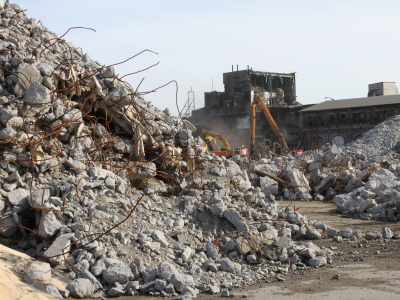In the bowels of the former St. Marys Paper mill, a paper-spooling machine sits gathering dust, a giant spindle of paper still threaded through its components, silenced after decades of operation. When production stopped here in the spring of 2010, everyone just walked away, leaving more than 100 years of paper production, machinery, wood and employment behind.
In a matter of months, the machinery and all modern buildings will be gone when demolition makes way for new development, which will include a bioenergy component, as proposed by the Sault Ste. Marie Innovation Centre and Riversedge Developments.
The two organizations are teaming up to transform a part of the 75-acre property into an “advanced bioenergy and smart energy park,” which will allow for research and pilot plants related to biofuels, district heating, alternative energy technology and a technology research facility. It will be one component to the Smart Energy Strategy devised by the city earlier this year.

Willem Galle (above, left), chair of Riversedge Developments, and Jason Naccarato, vice-president of development at the Sault Ste. Marie Innovation Centre, say the future of the St. Marys Paper site will be guided by bioenergy.
“Our role would be to develop partnerships and look for technologies that would be a good fit for here,” said Jason Naccarato, the innovation centre’s vice-president of development. “We’d also look at technology transfer and commercialization and try to take some of these research projects into spinoffs, and just look out for any technology-based partners we can come and bring to the site.”
Expansion into bioenergy will augment the city’s mandate as the “alternative energy capital of North America,” while creating jobs, encouraging research and boosting economic development by creating spinoff companies located in the Sault, Naccarato said.
Talks about creating a combined heat and power (CHP) project on the site are ongoing, and Naccarato said Essar Steel Algoma has expressed preliminary interest in getting involved. An advisory committee is being assembled comprising members from Sault College, Algoma University, the Economic Development Corporation and Riversedge, and representatives from private sector companies are being sought as well.
Riversedge proposes turning the site into a combined research/residential/office space. After purchasing the property last spring, Riversedge held consultations to get community input and began site reclamation efforts. The original sandstone buildings will remain on site—the administration office has been deemed a heritage building and can’t be touched—while all modern buildings will be removed by Christmas.
Willem Galle, executive chair at Riversedge, envisions condos and executive offices where the bulk of the mill was located, on the eastern portion of the site, with the research and pilot plant component located on the western edge, closer to the International Bridge.
A green space will act as a buffer between the sites and Galle proposes a community gathering place for one of the buildings at the centre of the property. Comprised of sandstone and being dubbed ‘Mill Square,’ the structure had been hidden by conveyor belts and was only rediscovered when demolition had begun.

Spindles of paper were left threaded through machines after the mill closed in 2010.
Sault architectural firm EPOH has been contracted to study the residential component of the project. Final details are far from complete, and Galle cautions time is necessary to ensure the proper plan is hatched for the site.
“Everybody is willing to talk new ideas, but nobody is planning to do anything stupid,” he said.
Now that the city and Riversedge have created a framework for economic development for the site, they can go ahead and fill in the details, he added.
“Before it really gets contracted, there needs to be a more comprehensive plan, but the thing about this sort of planning, it’s not really planning, it’s more designing,” he said. “With a design you need to start with some fixed point on the compass because otherwise the details never come.”
There has already been interest in using the administration building for office space, and in early fall, a film crew repurposed one of the more derelict buildings to emulate a bombed out Afghanistan cave. The local police service has even used some of the buildings for training.
The mounds of debris accumulating on site will all be recycled or repurposed, Galle said. Concrete will be crushed to use as fill, while metal and rebar can be recycled. However, it’s unknown what will be done with the stacks of wood that remain on site.
It belongs to the Ministry of Natural Resources, Galle said, and it will be up to the ministry to collect it from the site. Untouched for more than a year, the wood is likely no longer fit for use in paper-making, but it could be turned into pellets or wood chips, he added.
Naccarato said that, with the cost of oil rising, it makes good business sense to invest in renewable energy technology that doesn’t rely on government subsidies, while providing a rejuvenation of a dying forestry industry.
“This whole industry was built on the old way of Canadian forestry, and the old way of making money off the forests and monetizing the forests,” Naccarato said. “I think it’s going to head in the next era of forestry monetization.”




